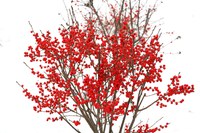Dakota Gardener: The best holly for the north
(Click an image below to view a high-resolution image that can be downloaded)
By Tom Kalb, Horticulturist
NDSU Extension
The holidays are here!
It’s time to decorate our homes with the colors of the season. As the song goes: Deck the halls with boughs of holly, fa-la-la-la-la, la-la-la-la.
Holly has been a favorite decoration in winter celebrations for centuries. Ancient cultures saw its lively red fruits and green leaves in the dead of winter and believed holly was a symbol of long life.
Kings wore crowns of holly for good luck. Holly was believed to repel witches too.
I am not too worried about witches, but it is wonderful to grow holly and use it for homegrown holiday decorations.
We can’t grow evergreen holly in North Dakota, because it’s too cold here. However, we can grow winterberry, the best holly for the north.
Winterberry will shed its leaves in fall, revealing bright berries in shades of red and orange. These fruits add a wonderful burst of color in snowy, winter landscapes. The fruit-filled branches can be clipped in early winter for use as fresh, long-lasting decorations.
Growing winterberry requires special care. The shrub prefers acidic soil, and you will likely need to acidify the planting site. Start with a soil test to measure the current pH. If the pH is manageable (7.5 or lower), we can make it suitable for holly.
Add an 8-inch mound of peat moss on the site and the recommended amount of sulfur. Mix this into your soil. You will need to monitor the pH every year to keep it acidic and your holly healthy.
Next, it is important to know there are male and female holly bushes. Only female bushes bear fruits. Male hollies are fruitless and plain looking, but we need one within 50 feet to pollinate the females.
One male can pollinate approximately 10 female shrubs. When you buy a female holly, a compatible male holly which blooms at the same time will be recommended.
Winter Red is one of the finest cultivars. This female shrub has an abundant display of red fruits that persist through much of winter. The rounded shrub grows slowly, reaching up to 8 feet tall. Use Southern Gentleman as the male.
Compact cultivars of winterberry are available. These grow about 4 feet tall and fit easily into home landscapes. Berry Poppins is truly dazzling in the winter landscape. Use Mr. Poppins as its male.
Red Sprite is another great compact selection. Its berries are large and intensely red. As a bonus, the leaves of Red Sprite in summer are dark green and shiny. Jim Dandy is the recommended male pollinator.
Fill your holidays with the beauty of homegrown holly. Happy holidays!
For more information about gardening, contact your local NDSU Extension agent. Find the Extension office for your county at www.ndsu.edu/agriculture/extension/county-extension-offices.
NDSU Agriculture Communication – Dec. 20, 2022
Source: Tom Kalb, 701-328-9722, tom.kalb@ndsu.edu
Editor: Elizabeth Cronin, 701-231-5391, elizabeth.cronin@ndsu.edu




